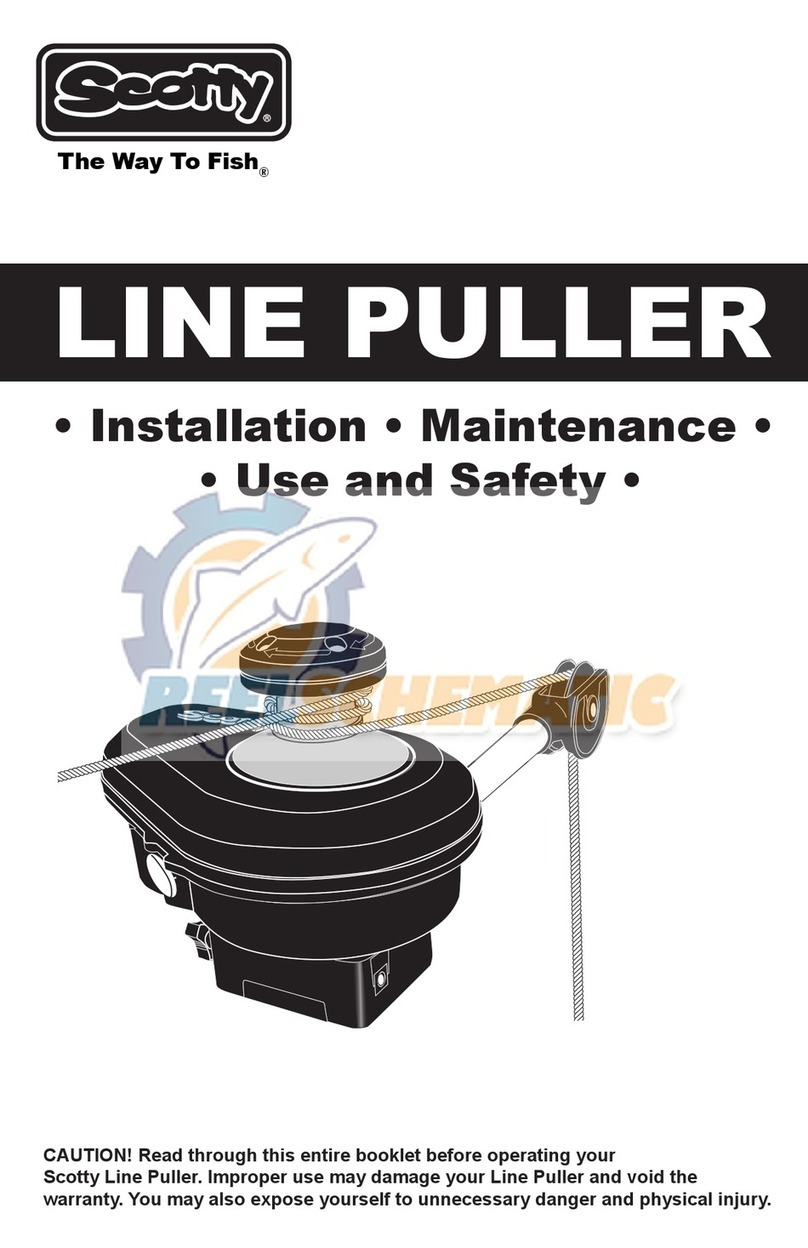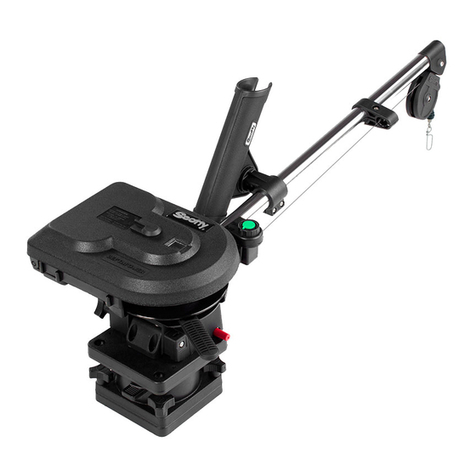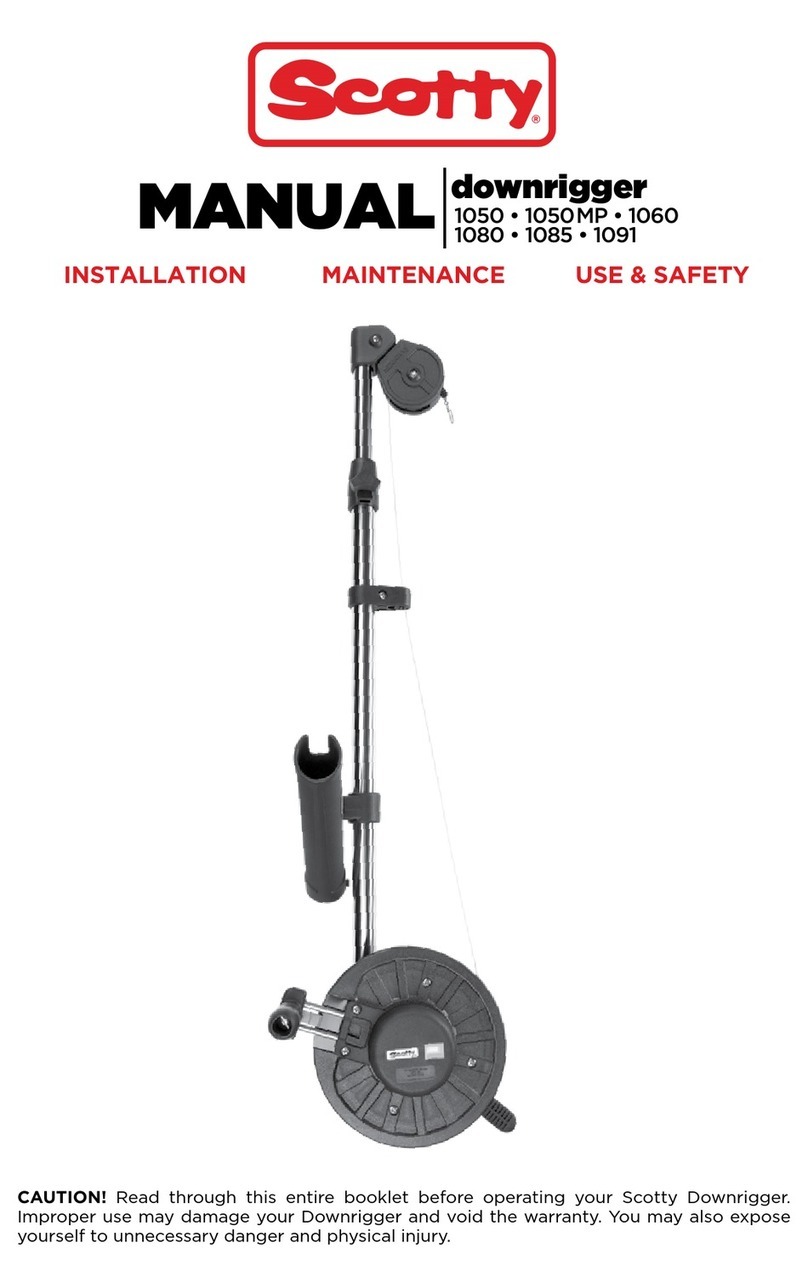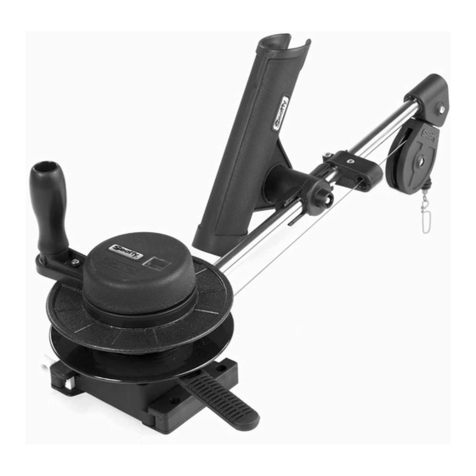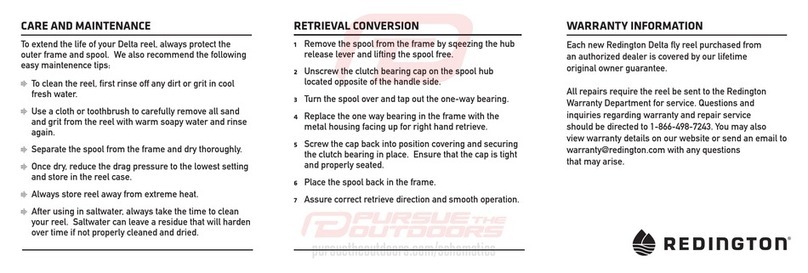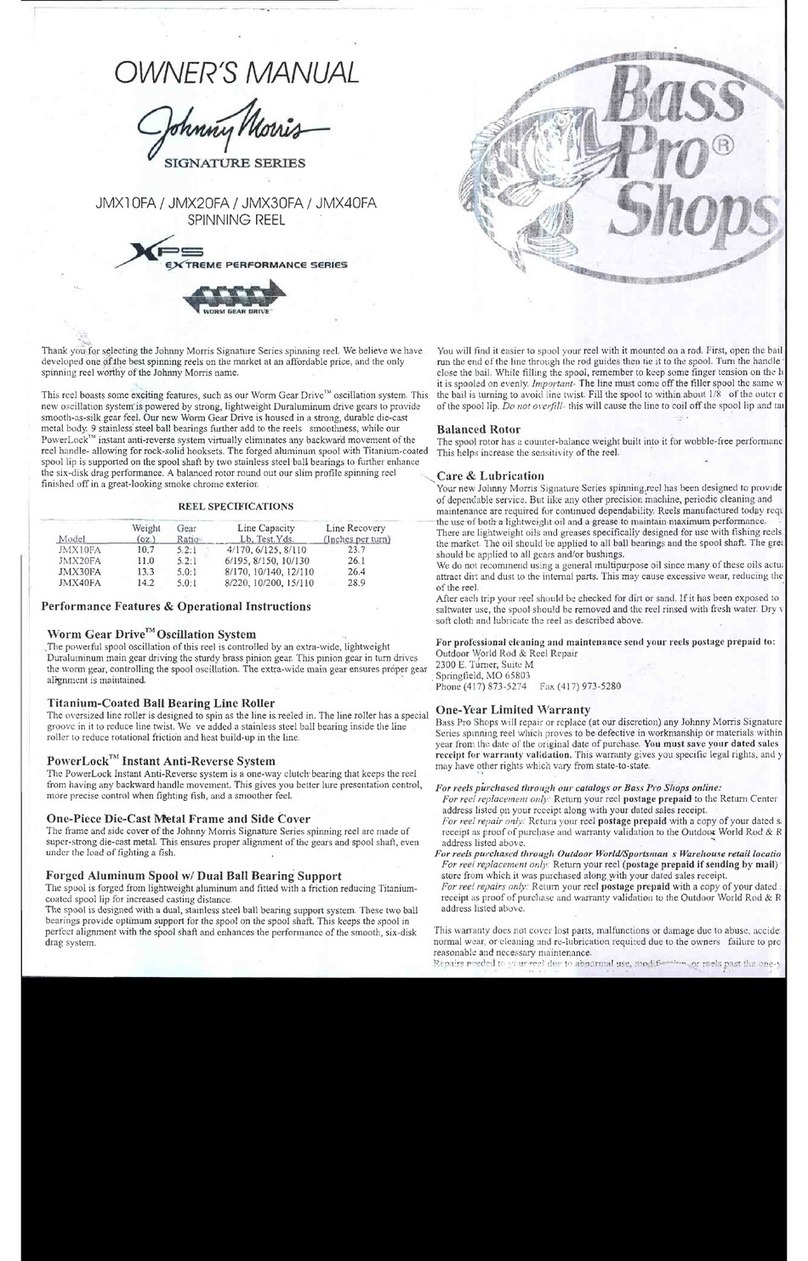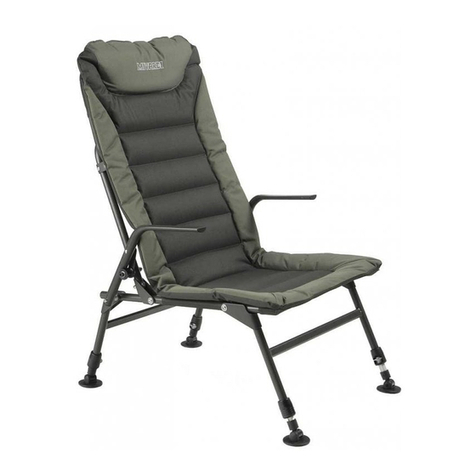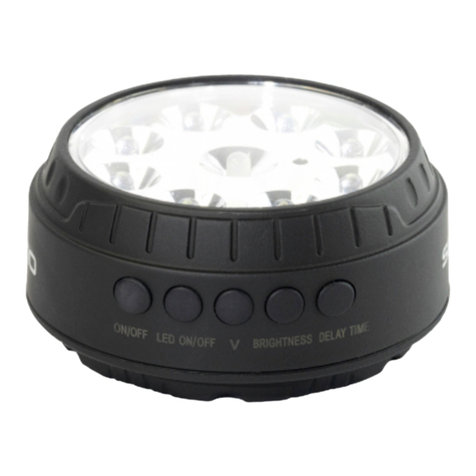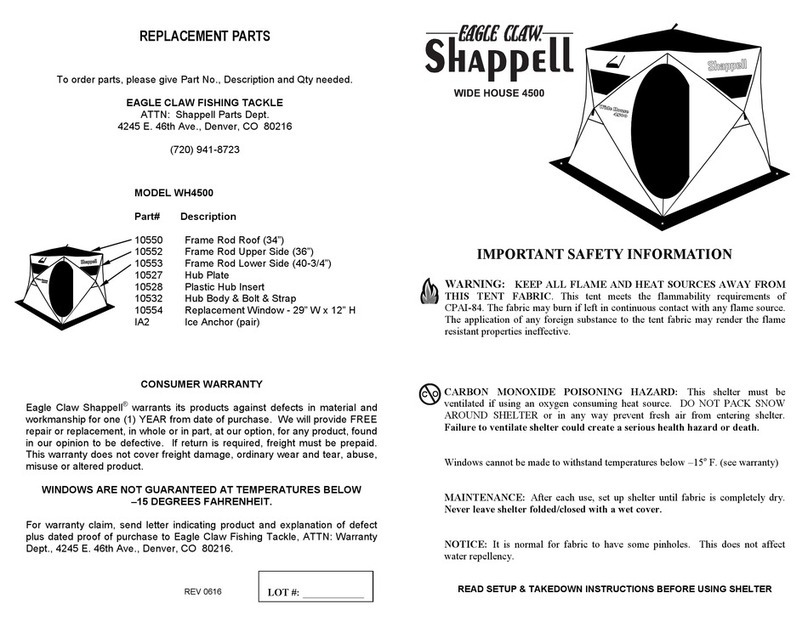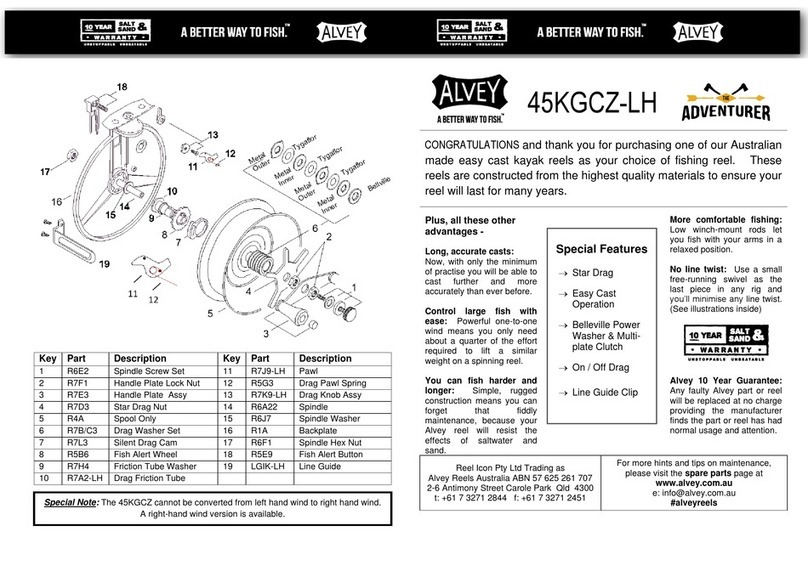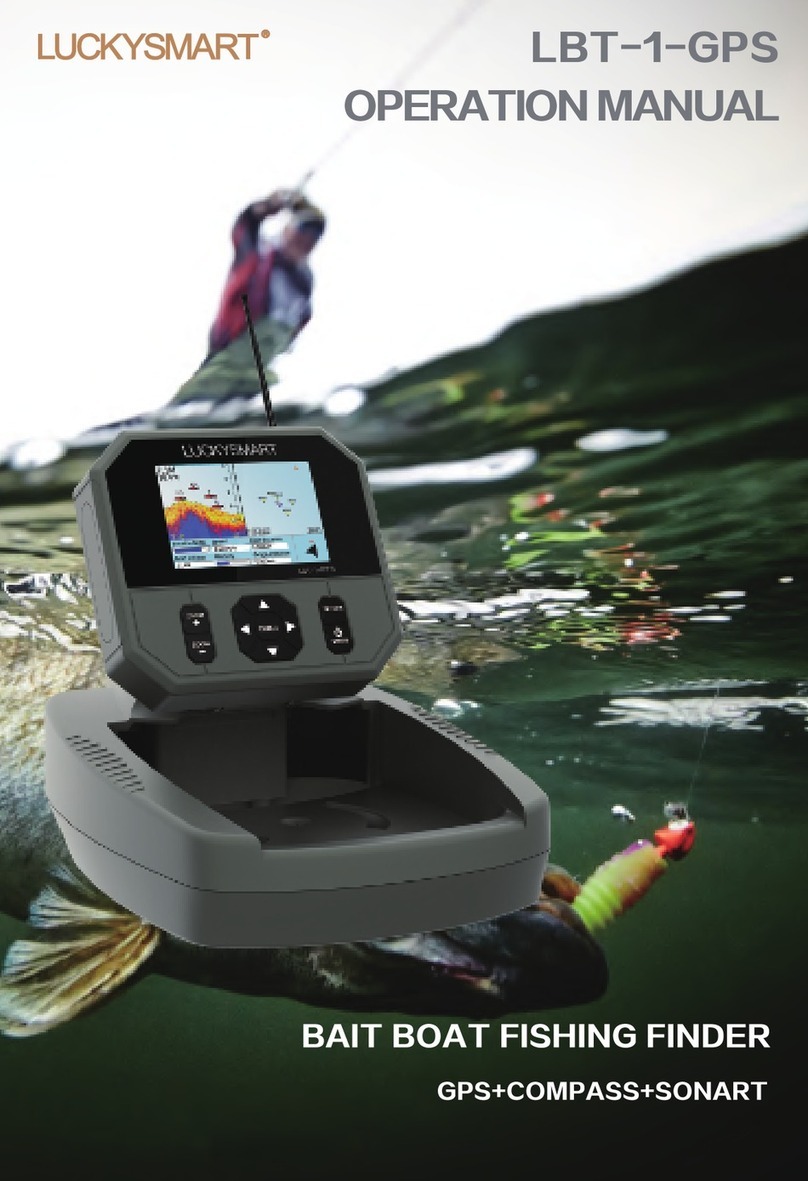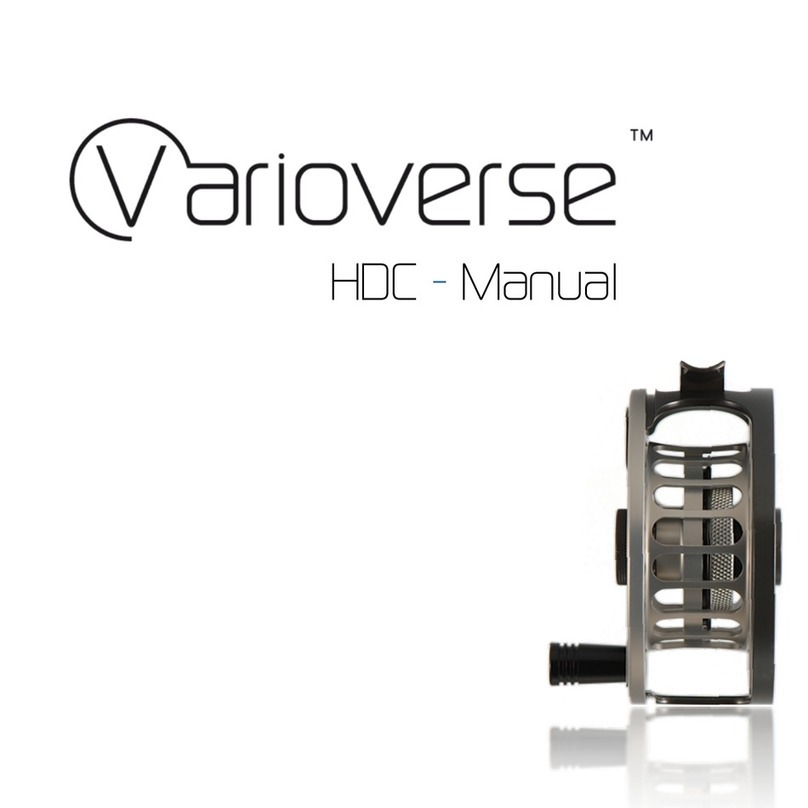Scotty HIGH PERFORMANCE ELECTRIC DOWNRIGGER User guide

• Installation • Maintenance •
• Use and Safety •
CAUTION! Read through this entire booklet before operating your Scotty Downrigger.
Improper use may damage your downrigger and void the warranty. You may also
expose yourself to unnecessary danger and physical injury.
The Way To Fish™
HIGH PERFORMANCE
ELECTRIC DOWNRIGGER

2
Electric Downrigger Manual
Thank you for choosing a Scotty Downrigger. In 1973 Scotty produced its rst
downrigger. Our goal was to manufacture a superior downrigger, built to
withstand the demanding marine environment and we now produce many
manual and electric models. This instruction book will give you basic instruction
on mounting and using your downrigger. Please read carefully. It will improve
your results and also give you important tips on downrigger safety and care.
Good Fishing!
Features
Original Purchaser Limited Lifetime Warranty
Scotty is proud to warranty your High Performance Downrigger for the lifetime
of the original owner. To register your factory authorized warranty you must
send your completed warranty card along with proof of purchase and serial
number (found under your downrigger lid) to Scotty, either online, mail or fax.
For warranty inquiries, please contact Scotty Fishing, Marine and Outdoors
at 1-800-214-0141 or 250-656-8102, or one of our authorized warranty repair
service depots (see www.scotty.com or call us for the depot nearest you). We
will do our best to get you back shing as soon as possible.
Speed & Efciency
The Scotty High Performance Downrigger’s drive mechanism incorporates a
positive drive gear belt to turn the downrigger spool. This highly efcient belt
system is used by many auto makers for valve timing, and the benet to the
sherman is that power is transferred from the motor at a greater efciency
than worm gear drives used in most electric downriggers. The result is a faster
retrieval speed with less electric power used. The Scotty High Performance
Downrigger will retrieve at speeds two to three times faster than most electrics.
Clutch Brake
The Scotty clutch brake allows descent of the downrigger weight at any speed
you choose. Most of the time you will want a slow, even descent speed to avoid
tangles. However, in instances where you want a lure deep very quickly, the
Scotty HP will respond, giving you complete control. The clutch brake has been
factory set to pay-out if you hang up on the bottom, but must be calibrated for
your particular environment. Changes in temperature, humidity or the amount of
weight you use with your downrigger will alter the performance of the brake. You
must adjust the brake to suit your particular conditions prior to each use. See
page 13 for step by step instructions on how to adjust the brake.
Auto-Stop
Auto-Stop control permits hands-free line retrieval and Scotty line beads (pre-
installed on your downrigger) allow you to stop your downriger at any pre-set
point. Scotty line beads can be positioned anywhere on your downrigger line
and must be checked prior to each use to conrm they are present and properly
located. Missing or improperly located line beads will not turn the unit off in
its desired location. The downrigger will continue to retrieve beyond the point
where you want it to stop and may cause line failure or terminal tackle failure
and may result in personal injury.

3
Fishing with Downriggers
Downrigger shing is a whole new style of trolling. It may take a little while to get
used to it, but after you begin to catch sh with it, you’ll never go back to using
heavy tackle. Unlike conventional trolling, the rst evidence of a strike may show
with just a wiggle of your rod tip or your downrigger pulley. When a sh strikes,
your rod tip goes up, the line will momentarily go slack and you now have your
sh on the line with no weight at all! Quite often, the sh will rush to the surface
(with no weight to hold him down) and put up a spectacular ght right on top.
After a strike, note the reading on the depth counter
so you can get your line back to the exact same
depth after landing the sh. Many suspended sh
travel in schools and returning to the exact same
location will increase your chances of hooking up
again.
If the sh is large we suggest you retrieve the
downrigger before you land the sh. This eliminates
the possibility of the sh tangling in the downrigger
line or the weight hitting the bottom if you drift
into shallow water while playing the sh. To avoid
tangles you should wind up all downriggers on the
boat before you stop to drift. If shing alone, you
should get your sh under control
and then retrieve the downrigger.
Digital counter
The Scotty HP downrigger uses a permanently sealed digital line counter to
show the depth of your downrigger weight. The battery cover is sealed and
cannot be opened without destroying the integrity of the counter.
Directions for use:
• To turn the counter ON, press
ZERO
PWR .
• To turn the counter OFF, press and hold
ZERO
PWR for 5 seconds (the counter will
turn off automatically after 24 hours if not used).
• To illuminate the counter, press (back-light will turn off after 30 seconds)
• To reset the counter to zero, press
ZERO
PWR .
• To toggle the units of measure between “FEET” and “METERS”, press and
hold for 5 seconds
Under normal use the counter should last many years. Heavy use of the back-light
will greatly reduce the life of the counter. Replacement counters can be obtained
at your local Scotty dealer or by contacting the factory directly (contact information
can be found on page 16).

4
Downrigger Safety
The Scotty High Performance 30” xed and 60” telescoping boom electric
downriggers are designed for use on wide beam boats of 16 ft. in length and up.
Installation on smaller boats is not recommended. All sports have some physical
hazards connected with them and shing with downriggers calls for some common
sense and precaution.
There are natural physical forces associated with long
arm downriggers. The load or strain at the mounting point
of a downrigger is proportional to the length of the arm.
In the event of a bottom hang up with a 30” - 60” arm and
high breaking strength trolling wire, the arm leverage can
exert a tremendous force on the gunnel of your boat. It is
obvious that this force could overcome a weak mounting
point on the boat. In the case of a small boat, it could
cause the boat to submerge or overturn if the wire is
caught on the bottom in a strong tide or heavy wind.
Care must always be exercised to avoid tangling your
downrigger wire in your boat prop. The best way to avoid
this risk is to mount the downrigger near the stern of the
boat so that the wire never gets under the boat in a turn.
Sharp turns should be avoided if possible.
When the downrigger is tilted up, the boom must be tilted
back past vertical, and the red lock lever tucked fully under
the downrigger base.
Keep your ngers away from the underside of the
downrigger base and always remove the weight when
the downrigger is unattended or in the locked tilted
position.
Make sure the area where you are mounting your
downrigger is strong and reinforced. If it is weak, reinforce
it with a backing plate of wood or metal.
Always try to bring weights, releases, and tackle inboard
to you. When retrieving or hooking up, do not lean out, as
a sudden roll or a slippery deck could send you overboard.
Do not attempt to retrieve a weighted or snagged
downrigger cable by hand. Wave or boat motion could cause serious injury.
VERTICAL
Red lock lever must
be tucked under
base to lock
the downrigger upright.
Always remove
the weight when
the downrigger is
unattended or in the
locked tilted position.

5
What happens when you hit bottom?
When your weight touches bottom while trolling, you will see the downrigger boom
bounce. You should immediately bring your weight up to a safer depth.
WARNING! Be very cautious when shing in strong tidal currents or on windy
days. If the weight or wire snags on the bottom, the force of the tide or wind on the
boat can put a terric strain on the downrigger.
KEEP a pair of wire cutters handy in case you have to cut the wire in an
emergency! Because of the built in tilt-up feature, the downrigger boom may
y up quickly when the wire breaks or is cut, so be sure to stand clear, not
leaning over the boom.
We recommend you always have a large scale chart of your shing area and know
your position at all times when deep trolling. With a relatively smooth bottom, if
your weight hangs up on a small ledge it can often be released by turning around
and pulling from the opposite direction. The wire line can be paid out if necessary
while you turn the boat to the direction of the hang-up. After a hang-up, the wire
should be examined for any broken strands. If strands are broken, it can be cut
and rejoined as a temporary measure but should be replaced as soon as possible.

6
Wiring Instructions and Installation
WARNING:
Batteries contain a large amount of potential electrical energy. Extreme care
must be used when working with batteries. An improper connection to a
battery can release enough energy to cause severe injury or re.
PLEASE READ THROUGH ALL ELECTRICAL INSTRUCTIONS PRIOR TO
INSTALLATION AND WIRING.
Required for Installation and NOT included with this kit:
• 30 amp fuse with fuse holder ( Scotty part No. 1124)
Overcurrent Protection
The wiring between the battery and the receptacle must have proper overcurrent
protection in the form of an inline 30-amp fuse. It is this inline fuse that may
prevent an electrical re in the event of a short circuit. Position the overcurrent
protection within 7” of the battery.
Wire Gauge
Use good quality marine grade tinned electrical wire to bring power to your
downrigger. To determine the correct gauge of wire, measure the “wire run length”
which is the distance from the positive (+) power source connection, to your
downrigger and back to the negative (-) power source connection. For wire run
lengths up to 25 feet, use minimum 12 Ga. wire, for runs of 25– 40 feet use 10 Ga.
wire. Wire smaller than the recommended gauge will not carry sufcient power to
operate your downrigger at its rated speed and power, it will run noticeably slower.
We Recommend:
Scotty premium 12 gauge, 2 Conductor Downrigger Power Wire (Scotty part
No. 1133) has been designed specically for return runs of 25 feet or less. It is
manufactured with heavy duty, annealed, tinned copper which provides maximum
current ow and improved corrosion resistance.
NOTE: The downrigger should always be unplugged when not in use.
1 1/8"
Receptacle template

7
Receptacle Installation & Wiring
It is important that the receptacle is wired to match how the plug is
wired.The terminals marked “1” and “2” on the receptacle mate with the
corresponding terminals marked “1” and “2” on the plug.
1. Mounting the receptacle requires a 1 1/8” hole to be drilled. Select
a location where the boats structure will not be weakened. Also,
mount on a vertical surface to lessen the amount of water that
can enter the receptacle. Alternatively, you may want to mount
the receptacle using the Scotty L-bracket (included in your
downrigger kit)
2. Using the template on page 6, mark and drill the required holes.
3. Slide the rubber receptacle protection boot onto the wire. Strip
the wire insulation back ½” to expose clean bare wire. DO NOT
solder the ends of the wires.
4. Feed the wire from the back, through the 1 1/8” hole. Insert the
negative (-) wire into terminal “1” and the fused positive (+) wire
into terminal “2” and tighten both terminal screws. Make certain
there is no wire insulation inside the terminals and that there are
no stray wire strands outside the terminals. Do not overtighten!
5. Mount the receptacle. Ensure the drain hole is facing down.
6. Push the rubber receptacle protection boot onto the receptacle
from the backside.
Circuit Breaker
Your Scotty electric downrigger is equipped with an automatic circuit
breaker to protect the motor from overload. If you hang up on bottom
or snag a heavy mass of weeds and then push the power up button,
the circuit breaker will probably trip. Wait 5 to 10 seconds for it to
automatically reset and you will have power again. However, do not
repeatedly attempt to lift a load too heavy for the downrigger motor. If
possible, the downrigger line must rst be freed from the obstruction.
12 Volt Battery
In-Line 30 amp Fuse

8
Mounting Instructions
All Scotty electric downriggers mount on the Scotty No. 1023 tilt-up mounting
bracket supplied with the downrigger. This bracket can be bolted directly to your
gunnel or on top of an alternative mount (for additional mounting options see
page 15). Downriggers can be mounted on either side of the boat, on the stern or
on either corner. They will work in any location but the risk of tangling wire line in
your prop while turning the boat is minimized the further back the downrigger is
mounted.
You will be handling heavy weights and setting lines and releases, ensure your
mounting location is convenient and safe for these operations. Do not mount the
downrigger where you have to reach or lean a long way to make the connections.
The addition of a Scotty Weight Retriever (Scotty part No.3025) will lessen the
amount of reaching and leaning you may have to do.
Due to the heavy stresses placed on the boat gunnel by the leverage of the long
downrigger arm, we recommend that a wood or metal backing plate always be
installed on the underside of the mounting surface. This spreads the load and
reduces damage to the boat in the event of a bottom hang up.
You should also consider rod holder mounting locations when deciding where to
mount your downrigger. Scotty High Performance Downriggers come standard
with either boom mounted or dual platform style rod holders. Another option
is to move the boom rod holder body forward on your boom to accommodate
even more rod holder options available from Scotty. You may choose to use the
supplied rod holder as is, or mount additional rod holders on your boat. Rod
holders work equally well when mounted either fore or aft of the downrigger.

9
Rigging Your Fishing lines
This section details the procedure of how to use your downrigger in conjunction
with a shing rod, read it carefully. It is best to rig your lines while your boat is in
forward motion, this will help prevent tangles.
1. Once your downrigger is properly mounted, push the downrigger
brake handle forward to ensure it is in the locked position. Attach your
weight to the downrigger snap hook. Use enough weight to ensure the
downrigger cable does not drag back at more than a 30 degree angle
when travelling at trolling speeds. 12 to 15 lb. is adequate for most
shing conditions.
NOTE: Always keep tension on downrigger wire. Downrigger wire could
kink or spill off spool edges if it becomes slack.
2. The AUTO STOP shuts off the downrigger when a line bead passes
through it and triggers the shut off switch (line beads have already been
installed on the downrigger cable). You can add more line beads at any
point on the cable where you would like the downrigger to stop.
3. Ensure your line beads are
present and properly located
prior to using your Scotty
Electric Downrigger
4. Have the AUTO STOP switch
in the “OFF” position, pointing
in line with the boom.
5. Connect the power source.
6. Lower the weight down
approximately ten feet.
7. Turn the AUTO STOP switch to “ON” and your downrigger will stop as
soon as your line beads enter the gate passage.
8. Your release clip should always be located at least ve feet lower than a
line bead.
9. Push the jog button to bring the weight or release clip up to the pulley.
NOTE: The Scotty High Performance downrigger is equipped with a high
speed, high torque motor. Extra caution should be observed when jogging
your downrigger weight near the surface. When retrieving your weight near
the surface you may want to apply the brake while pressing the jog button at
the same time. This will help you retrieve the weight at a slower speed. This
should only be done for the nal few feet at the surface when you wish to lift
your weight out of the water.

10
10. Clip the snap of the Power Grip release (included in your downrigger kit)
to the downrigger weight, or if using a trolling snap style, a few feet up
from the weight. Let between 5 - 30 ft. of shing line out (with your bait or
lure attached to the end) then attach your shing line to the Power Grip
release by squeezing the jaws apart and placing your shing line between
the pads (see diagram on page 3). You can adjust the release tension by
placing the shing line further into the jaws. To further increase the release
tension you can move the tension adjuster slider to the out position.
11. With your shing rod in a rod holder, set the tension on your reel so that
the line will pay out, but with enough drag tension so that it doesn’t free
wheel. It is important to have your shing line tight to the downrigger line
because you may lose the sh if it has slack line after releasing from the
downrigger release clip.
12. The downrigger weight is lowered by moving the brake handle in a
clockwise direction. You can go as fast or as slow as you wish, but it is
usually best to descend at a slow, even rate to eliminate fouling your
shing line and tackle with the downrigger cable.
After each use, it is advisable to rinse off your downrigger with fresh water to
avoid salt build-up. The unit is made of non-corrosive materials, but a build
up of salt and seaweed could affect performance.

11
Downriggers Do’s and Don’ts
DO Check your downriggers clutch brake prior to each use to ensure it is
correctly set.
DO Check that your auto-stop line beads are present and properly located
prior to each use.
DO Attach your rod and reel line to your downrigger while your boat is in
forward motion, this will avoid tangles.
DO Read the depth counter when you catch a sh, then go back to the
same depth.
DO Replace cable regularly to avoid lost gear.
DO Rinse off your downrigger with fresh water after each use, if used in
saltwater.
DO Clean power plugs regularly
DON’T Use heavier weight than shing conditions require. Heavy weights
reduce performance and efciency, and shorten wire life. 12 - 15 lb.
should be ample for most shing conditions.
DON’T Let the downrigger wire go slack. Kinks may form or the wire could spill
off spool edges.
DON’T Let your shing reel spin free while you lower your downrigger, set a
light drag.
DON’T Use nylon or other monolament line on your downrigger. Nylon will
stretch in use and shrink back on the spool with enough force to
damage it. Use of Nylon line will void the downrigger warranty.
Use of Scotty brand braided line will not void your warranty
DON’T Spray downrigger or wire with lubricants, oils or cleaners (ex. Armor
All®), as these will damage the plastic, may cause brake malfunction
and will void your warranty.
DON’T Attempt to retrieve a weight or snagged downrigger cable by hand.
Wave or boat motion could cause serious injury.

12
Emergency Crank Handle
Before shing with your Scotty Depthpower for the rst time, you should familiarize
yourself with the use of the Emergency Crank Handle A. This device is intended for
use when a power loss has occurred and the weight must be retrieved.
1. DISCONNECT POWER TO THE DOWNRIGGER.
2. Ensure the auto-stop control is in the off position.
3. Slide the latches on the front and back of the downrigger chassis to the
‘unlocked’ position and lift the lid off.
4. Immediately place the lid in a safe, inboard location to prevent accidental
loss.
5. Lift the Emergency Crank Handle Aoff the locating pin Band pull it
sideways off the nut C.
6. Lift the Drive Belt Doff the spool gear Eand put it in a secure place(inside
the upturned lid is good).
7. Slide the non-forked end of the Emergency Crank Handle A into the slot
on the top of the spool gear Eat a 45° angle. You will now be able to
crank up the wire line using the Emergency Crank Handle A.
8. The parts that have been removed should be installed in the reverse
order they were taken off. Rotate the Counter Pressure Plate Assembly F
so that the Emergency Crank Handle A is aligned between the supports.
Lift the Emergency Crank Handle A over the locating pin Bto engage its
hole onto the pin.
9. The Emergency Crank Handle Amust always be securely in place when
the downrigger is in use under power, as it ensures correct alignment of
the drive unit. Make sure the parts are reassembled correctly and the lid
is properly positioned and locked before connecting the power.
A
B
C
D
E
F
SLOT

13
Care And Maintenance
Your Scotty Electric Downrigger is constructed with corrosion resistant
materials. The following regular maintenance checks should be performed:
1. Rinse with fresh water after every use.
2. Routinely check the stainless steel fastenings with a screwdriver to see
that they are snug and secure.
3. Check the electrical plug connectors for corrosion and clean off any
corrosion found. Failure to clean corrosion may cause electrical arcing
and shorting which may be a potential re hazard.
4. Do not use any lubricants. Lubricants will attack the plastic components
and void your warranty.
5. Do not expose the downrigger to ultraviolet light for extended periods of
time. A fabric cover (Scotty product No. 3015) is available to protect your
downrigger from ultraviolet damage.
BRAKE ADJUSTMENT
Changes in temperature, humidity, and the weight you use will effect the
performance of your clutch brake. You must ensure your brake is properly adjusted
to allow the downrigger line to spool out in the event of a hang-up prior to each
use! Proper brake setting is obtained when you have adjusted the downrigger
brake to hold your weight in position when trolling but will pay out if it becomes
snagged.
1. DISCONNECT POWER TO THE DOWNRIGGER.
2. Ensure the auto-stop control is in the off position.
3. Remove any weight from the line.
4. Slide the latches on the front and back of the downrigger chassis to the
‘unlocked’ position and lift the lid off
5. Immediately place the lid in a safe, inboard location to prevent accidental
loss.
6. Move the brake handle to the “off’ position so that the spool can move
freely. Using a 9/16 inch wrench or the molded hex in the non-forked
end of the emergency crank handle, either tighten or loosen the nylock
nut as required to obtain the correct brake setting. Proper brake setting
is obtained when you have adjusted the downrigger brake to hold your
weight in position when trolling but will payout if it becomes snagged.
7. Make sure the lid is properly positioned and locked before connecting
the power.
8. Test your clutch brake setting prior to use.
NOTE: The clutch brake system on your downriggger will require periodic
adjustment and must be tested prior to each use. The brake pads and clutch
brake system should last the lifetime of the downrigger without requiring
replacement, just adjustment. Do not spray any lubricates or cleaners on
your brake pads or any other components of your clutch brake system as
this will void the warranty and may cause brake failure.

14
Care And Maintenance
WIRE MAINTENANCE
We have found many things can adversely affect the life of the wire. Included
in these are such things as; an unobserved kink, electrolysis caused by stray
electrical currents emanating from the boat, certain types of jelly sh and/or
minute sea creatures which may have a corroding effect when left on the wire.
Frequent inspection and wiping or washing wire with fresh water will help to
prolong the wire’s life span.
HOW TO REPLACE WIRE
1. DISCONNECT POWER TO THE DOWNRIGGER.
2. Mount the downrigger someplace secure (its regular boat mount is good)
and pull off the old wire. When you come to the end of the wire, cut the
loop off the downrigger spool.
3. Take the free end of the wire from the supply spool and thread it through
the pulley, fairlead and the autostop. Thread the wire through the holes
from the inside of the spool.
4. Tie an overhand knot in the wire, pulling it snug against the spool.
Tie a second overhand knot giving you a “square knot” and pull it snug.
Clip the excess line leaving a tail approximately 2 inches long. Secure the
loose tail with tape to keep it from fouling the remainder of the wire line.
5. Wind the wire onto the spool using the Emergency Crank Handle. For
directions on the use of the Emergency Crank Handle see page 12. Be
sure to let wire unroll from the supply spool, rather than spill off the side.
Avoid twisting or kinking the wire, keep tension on the supply spool to
wind the new wire on as tight as possible. (This operation is best carried
out with two people.)
6. Attach a new Scotty bumper and snap hook.
7. Ensure you add two new auto-stop line beads onto your downrigger line at
least 5 ft. up from your Scotty Bumper and line clip. This will ensure your
downrigger stops retrieving before your terminal tackle hits the pulley.
NOTE:
The digital counter is calibrated for optimum accuracy when using 300’ of
Scotty 180lb. test stainless steel downrigger cable (or Scotty 250lb. test
braid). Adding, removing or using a different diameter of downrigger cable
may result in inaccurate length measurements.
Scotty utilizes the highest quality wire available. As there are many causes
of wire breakage, wire is not subject to any warranty, expressed or implied.

15
Optional Mounts for your Downrigger
Right Angle Side
Gunnel Mount
No. 1025
Pedestal Swivel
Mount
No. 1026
Rail Mount
No. 1027
Pedestal Riser
No. 2606 - 6”
No. 2612 - 12”
Gimbal Mount
No. 1028 - 9”
No. 1029 - 12”
For more information on these and other Scotty products,
go to our website at www.scotty.com
Dual Rod Holder
No.447

16
Scan the above QR
code with your smart
phone
To obtain parts, information or to locate the warranty service
depot nearest you, contact:
Scotty Fishing and Marine Products
2065 Henry Ave West
Sidney, BC Canada
V8L 5Z6
Tel: (250) 656-8102
Fax: (250) 656-8126
Toll Free: 1-800-214-0141
Email: scotty@scotty.com
www.scotty.com
The Way To Fish™
Although Scotty makes every effort to ensure the accuracy of speci cations at the
time of publication, speci cations for products described in this publication are
subject to change without notice.
Contact Scotty for the most current information.
Serial # ______________________
Printed in Canada
Other manuals for HIGH PERFORMANCE ELECTRIC DOWNRIGGER
1
Table of contents
Other Scotty Fishing Equipment manuals
